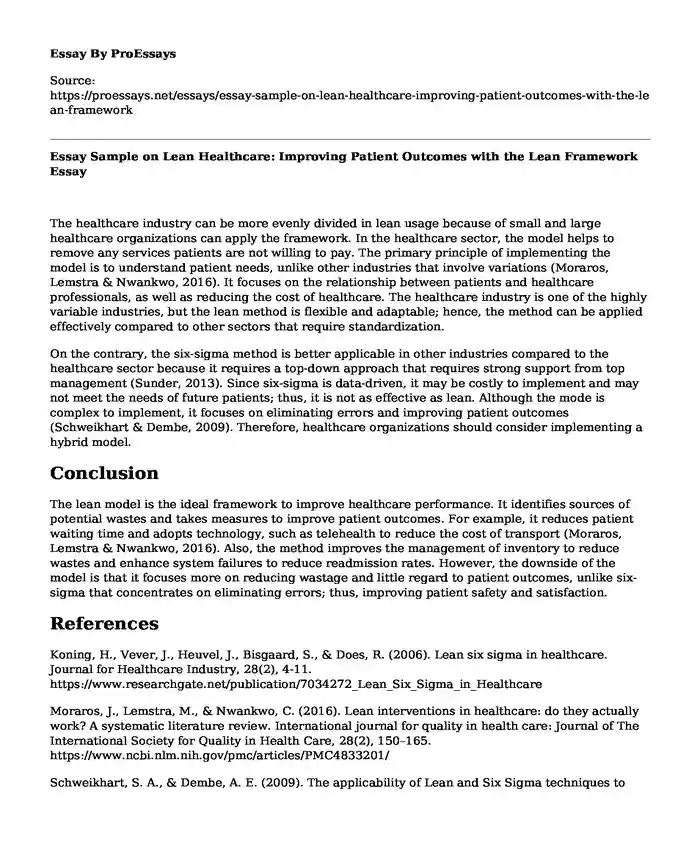The healthcare industry can be more evenly divided in lean usage because of small and large healthcare organizations can apply the framework. In the healthcare sector, the model helps to remove any services patients are not willing to pay. The primary principle of implementing the model is to understand patient needs, unlike other industries that involve variations (Moraros, Lemstra & Nwankwo, 2016). It focuses on the relationship between patients and healthcare professionals, as well as reducing the cost of healthcare. The healthcare industry is one of the highly variable industries, but the lean method is flexible and adaptable; hence, the method can be applied effectively compared to other sectors that require standardization.
On the contrary, the six-sigma method is better applicable in other industries compared to the healthcare sector because it requires a top-down approach that requires strong support from top management (Sunder, 2013). Since six-sigma is data-driven, it may be costly to implement and may not meet the needs of future patients; thus, it is not as effective as lean. Although the mode is complex to implement, it focuses on eliminating errors and improving patient outcomes (Schweikhart & Dembe, 2009). Therefore, healthcare organizations should consider implementing a hybrid model.
Conclusion
The lean model is the ideal framework to improve healthcare performance. It identifies sources of potential wastes and takes measures to improve patient outcomes. For example, it reduces patient waiting time and adopts technology, such as telehealth to reduce the cost of transport (Moraros, Lemstra & Nwankwo, 2016). Also, the method improves the management of inventory to reduce wastes and enhance system failures to reduce readmission rates. However, the downside of the model is that it focuses more on reducing wastage and little regard to patient outcomes, unlike six-sigma that concentrates on eliminating errors; thus, improving patient safety and satisfaction.
References
Koning, H., Vever, J., Heuvel, J., Bisgaard, S., & Does, R. (2006). Lean six sigma in healthcare. Journal for Healthcare Industry, 28(2), 4-11. https://www.researchgate.net/publication/7034272_Lean_Six_Sigma_in_Healthcare
Moraros, J., Lemstra, M., & Nwankwo, C. (2016). Lean interventions in healthcare: do they actually work? A systematic literature review. International journal for quality in health care: Journal of The International Society for Quality in Health Care, 28(2), 150–165. https://www.ncbi.nlm.nih.gov/pmc/articles/PMC4833201/
Schweikhart, S. A., & Dembe, A. E. (2009). The applicability of Lean and Six Sigma techniques to clinical and translational research. Journal of Investigative Medicine: The Official Publication of the American Federation for Clinical Research, 57(7), 748–755. https://www.ncbi.nlm.nih.gov/pmc/articles/PMC2835466/
Sunder, V. (2013). Synergies of Lean Six Sigma. The IUP Journal of Operations Management, 7(1), 1-13.
Cite this page
Essay Sample on Lean Healthcare: Improving Patient Outcomes with the Lean Framework. (2023, Sep 17). Retrieved from https://proessays.net/essays/essay-sample-on-lean-healthcare-improving-patient-outcomes-with-the-lean-framework
If you are the original author of this essay and no longer wish to have it published on the ProEssays website, please click below to request its removal:
- Social Change in the Community
- A Management Decision-Making and Index Number Paper Example
- Assigment Example on Enterprise Resource Planning of Business Process Systems
- Upgrade of the Information Technology Infrastructure of Zara Paper Example
- North Taita Optimal Health: Quality Nursing Care at Matter Health Care Hospital - Research Paper
- Essay Example on Memorial Hospital: Leadership Conflicts in a Growing Institution
- Leadership: Building Proactive, Resilient Teams for Internal Change - Essay Sample







